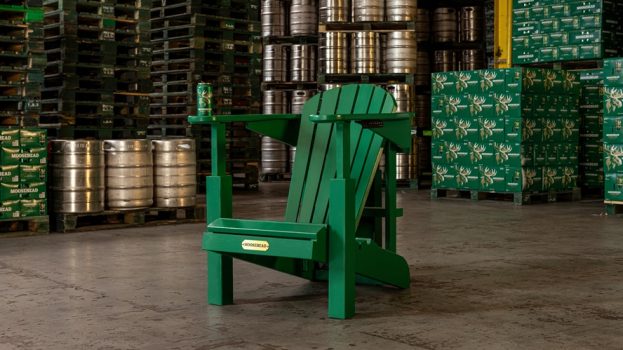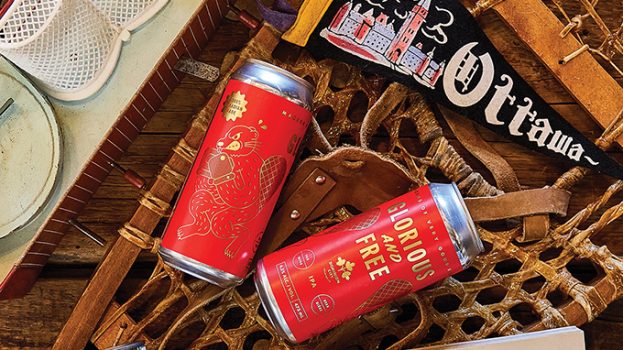This story appears in the April/May 2016 issue of strategy.
The most complicated marketing execution Molson Canadian did this year was decided on during its head of marketing’s first week in her new role.
“The Epic Rink was just coming off its first year, and my first week on the job was deciding what to do for the second,” says Christine Jakovcic, VP of marketing at Molson Coors Canada since June 2015. “When we made the decision to put it on a rooftop, I thought, ‘This could be my first and last decision in this job.'”
Luckily, the rink was a hit. The mere glimpse of it being built on a roof in Toronto’s Financial District had the city buzzing for a week before Molson finally admitted to being behind it. Interest in skating on it led to a second round of the #AnythingForHockey contest, with the brand eventually opening it up for people to rent ice time.
A principle Jakovcic says runs through all of Molson Coors’ marketing is “ideas acting as currency.” Those are the kinds of ideas that end up being worth more than just a creative execution because consumers pick them up for themselves and don’t feel like they’re “being marketed to,” she says, a constant pain point when trying to reach millennials in particular. This not only means looking for innovative ways to get attention outside of a TV spot (like a hockey rink on a rooftop), but building off what’s already exciting to its customers. Though Molson Coors will still be doing the big campaigns that come to mind when thinking of its bigger brands, Jakovcic is particularly keen on smaller brands that have strong, organic momentum without a great deal of marketing support.
For example, a recent campaign for Old Style Pilsner saw young, hip, urban millennials take a trip up to a Quebec ice-fishing shack to share the beer next to the working-class guys who’ve been drinking it for years.
“[Pilsner] has a unique positioning that’s starting to attract younger consumers without us having to do anything. People who are hunters or fishermen or outdoorsmen are still drinking it, and new consumers are picking up on that,'” Jakovcic says, which echoes how Pabst Blue Ribbon became a popular “hipster beer” in the U.S. “[The campaign] is a lot different than what a Coors Light Games or Molson Rooftop Rink would do to generate excitement, but with that consumer group, that’s what’s authentic and real and connected to the brand.”
When she’s not looking at smaller brands to support, Jakovcic is helping Molson Coors launch new products to reach niche audiences, like the new John Molson Archival Series. Faithful recreations of real recipes pulled from the brewer’s 200-plus year history – beers like the John H.R. Molson and Bros. 1908 Historic Pale Ale – are providing new flavour profiles steeped in tradition so they come across as more authentic.
“We probably have the broadest and most diverse roster of brands in Canada, which gives us more chances to tap into different consumer segments and meet their needs even as they change,” Jakovcic says. “If you’re trying to stay true to the core of what you stand for as a brand, that also means you can’t be everything to everyone. We need those other, smaller brands within the portfolio to reach everyone.”
The desire for new flavour profiles from authentic brands is part of what has been driving interest in craft beer, which Jakovcic says has been pushing Molson Coors to be on the top of its game. While the company keeps its craft-oriented brands – like Creemore and Granville Island – separate from its mainstream business, she’s been trying to tap into what’s been driving interest in craft, without outright imitating it.
“When you look at what some of the craft brewers are doing, it makes us think of what we used to do when we were a new brewer 200 years ago. We’ve taken it for granted as we’ve churned through traditional marketing models,” Jakovcic says. “Now, that’s been changing and we’re pushing ourselves to be better and different.”
Jakovcic took on her current role as part of a small executive shuffle that saw previous VP of marketing Dave Bigioni become VP of sales for Ontario and Western Canada. She was previously senior director of national revenue management, a role she says grounded her in the company’s business. “It was at the intersection of marketing, sales and finances, and we were responsible for drawing out what the drivers were for the business,” she says.
Jakovcic is not without traditional marketing bona fides, though, having spent more than 11 years in various marketing and sales roles at P&G in Canada and Western Europe, and almost three years as director of brand management and revenue strategy at Canadian women’s active apparel brand Lija before joining Molson Coors.
The previous year was a somewhat rocky one for the beer company. A declining dollar resulted in an extra hit to the company’s year-end report (it reports in USD), and an economic downturn has been especially hard on Alberta, one of its key markets. Overall sales volume decreased by 5.4% in Q4, while its market share declined by 1%. The company continues to face stiff competition from all sides, as Anheuser-Busch InBev purchased SABMiller to create a global beer giant last year, all while the popularity of craft brewers continues to surge.
Molson Coors has responded to results like these in past years by shifting budgets to focus more on “brand basics” and improving overall profitability. But now, the budget is beginning to shift toward brand-building and, most importantly for Jakovcic, the people behind the brands.
One of the first things she did after taking on her new position was to get her marketing team on the ground, particularly in Western Canada and Quebec, to connect the dots between communications and what was actually happening in-market. She also brought back the “Marketing Six Pack,” an internal training program that develops six core marketing skills, and instituted the “Breakfast Club,” a regular morning meeting between the marketing team and external partners like agencies and tech companies to discuss the trends and emerging technologies they are excited about.
“A brand by itself is not really anything. The people behind it are what makes it happen, so investing in the people working on a brand is an investment in the brand as well,” she says.
People are the priority, but the overall investment in Molson Coors’ brands is also increasing. While its marquee brands have always had some level of in-market presence year-round, the balance has traditionally tipped toward particular seasons to go along with their respective positionings – Molson Canadian in the winter to support its connection with hockey and Coors Light in the summer.
Jakovcic is looking to even out the scales again. The summer will see a new Molson Canadian campaign that will take the brand “on a journey only Canada’s beer” can make, and use the idea of “Canada’s beer” for activations around the Rio Olympics, World Cup of Hockey and the upcoming Canada 150 celebration. The Coors Light Games – a competition of backyard games like cornhole – will be returning for a second year, rounded out with activations in the winter months, as will the Mystery Mansion contest for VIP party access. A platform to tie all the various Coors Light activities together is being planned.
“Investing more in our people and our brands allows us to have more holistic, full-year programming,” she says. “We don’t want our consumers to have to make any other choices besides our brand. We want to make sure we’re there in all moments throughout the year.”
























